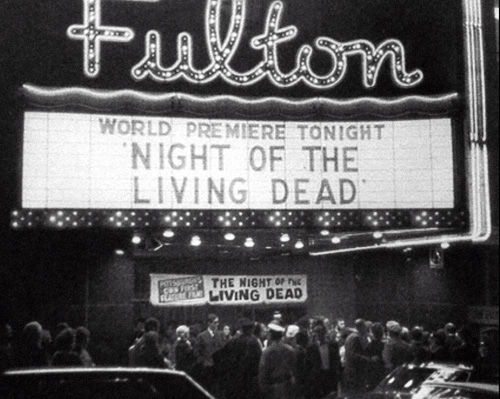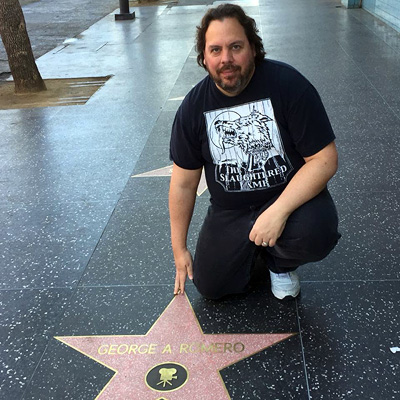“Night of the Living Dead is a classic that has inspired countless imitators, and spawned a sub-genre that continues to be exploited today in film, television, books and video games.” – John Scoleri, author of Latent Images: Night of the Living Dead
The Digital Bits and History, Legacy & Showmanship are pleased to present this retrospective commemorating the golden anniversary of the release of Night of the Living Dead, George A. Romero’s influential and franchise-spawning horror film about a group of characters trapped in a Pennsylvania farmhouse who are stalked by flesh-eating zombies.
Night of the Living Dead – co-written by John Russo and featuring Judith O’Dea, Duane Jones, Marilyn Eastman, Karl Hardman, Judith Riley, and Keith Wayne – opened fifty years ago this autumn, and for the occasion The Bits features a Q&A with author and film historian John Scoleri.
John Scoleri is the author of Latent Images: Night of the Living Dead (Dreams and Visions Press, 2019), and several books on artist Ralph McQuarrie, including The Art of Ralph McQuarrie: Archives (Dreams and Visions Press, 2015). He was co-editor (with Peter Enfantino and Robert Morrish) of The Scream Factory Magazine (Deadline Press, 1989-1997) as well as the 600+ page greatest-hits collection, The Best of The Scream Factory (Cemetery Dance, 2018). [Read on here...]
He produced the DVDs Caroline Munro: First Lady of Fantasy (2004) and Ralph McQuarrie: Illustrator (2002), and has contributed to several volumes on author Richard Matheson, including Bloodlines (Gauntlet Press, 2006). His article “Born of I AM LEGEND” appears in Fantasm Media’s Official Night of the Living Dead 50th anniversary Magazine (Fantasm Media, 2018), and he maintains numerous blogs where he continues to evangelize all the things that he loves, including the I Am Legend Archive (with a current count of 155 different editions from around the world, he claims to have the largest collection of Richard Matheson’s novel) (iamlegendarchive.com), bare•bones (with Peter Enfantino and Jack Seakbrook) (barebonesez.blogspot.com) and several episode-a-day TV show blogs, including the currently-in-progress Dark Shadows Before I Die (with his sister Christine) (dsb4idie.blogspot.com).
Scoleri kindly spoke to The Bits about the influence, appeal and legacy of Night of the Living Dead
Michael Coate (The Digital Bits): How do you think Night of the Living Dead should be remembered on its 50th anniversary?
 John Scoleri: I think the ideal way to remember the film on its 50th anniversary was to see the Museum of Modern Art’s 4K restoration on the big screen. I was honored to attend the 50th anniversary screening of the film a few weeks ago at the Byham Theater (formerly the Fulton) in downtown Pittsburgh, in the same theater where the film premiered in 1968. The majority of the surviving cast and crew were in attendance, and it was a wonderful way to celebrate the film.
John Scoleri: I think the ideal way to remember the film on its 50th anniversary was to see the Museum of Modern Art’s 4K restoration on the big screen. I was honored to attend the 50th anniversary screening of the film a few weeks ago at the Byham Theater (formerly the Fulton) in downtown Pittsburgh, in the same theater where the film premiered in 1968. The majority of the surviving cast and crew were in attendance, and it was a wonderful way to celebrate the film.
Beyond that, I think Night of the Living Dead should be remembered for the influence that it has had and continues to have on cinema and pop culture. It’s a classic that has inspired countless imitators, and spawned a sub-genre that continues to be exploited today in film, television, books and video games. It remains an important piece of cinematic history, both in how it helped usher in a wave of regional filmmaking, and how it broke new ground in terms of having an African American in a leading role for a character not defined by his race.
Coate: What do you remember about the first time you saw Night of the Living Dead?
Scoleri: Well, it was Friday, July 13th, 1979. I actually just published an essay on my decades-long search to confirm the exact date of my first viewing. Suffice it to say, mine is a pretty common tale among fans of my generation. I was 9 years old, and had heard about the film from my older brother who had seen it. He described it as being scary – even in the daytime! When a listing showed up in the local TV Guide indicating it would be on one of our local Creature Features programs, we made a point not miss it. While I don’t remember the specific details of the film from that first viewing, I do remember being wide awake when it was over, in a state of shock over how the film had ended with the death of our hero, and his unceremonious inclusion in the bonfire with the ghouls. None of the monster movies that I had seen up to that point in my life had prepared me for this. After a single viewing, Night was my all-time favorite horror film, and it remains so to this day.
Coate: In what way is Night of the Living Dead a significant motion picture?
Scoleri: I appreciate that you didn’t constrain that to “horror,” because I think the film, and its importance, transcends the genre. There is no questioning that as a horror film it was groundbreaking. The unrelenting tone and graphic depictions of gore pushed boundaries far beyond most films of the period, certainly in terms of their stark, realistic portrayal. But beyond the film’s horror elements, the underlying theme of a group of people being unable to work together in order to survive will always be relevant and relatable to modern audiences. And it cannot be overstated that the casting of Duane Jones (who delivers an amazing performance in the lead role) provides the film with a historical relevance that still reverberates today.
Coate: How do you think the numerous sequels, remakes, etc. compare to the original ’68 movie?
Scoleri: I’m a huge fan of Dawn, Day and Land of the Dead. Day was the first of Romero’s films that I saw in a theater, and is probably my second favorite behind Night. I love how the film establishes how widespread the problem has become in the opening sequence in Florida before it settles in to the more intimate and claustrophobic setting of the underground mine. I also think that Tom Savini’s make-up effects in Day of the Dead have never been topped; and there have been a lot of zombie films and TV shows since 1985.
I’m less fond of Diary and Survival of the Dead, as I feel those two films were compromised by budgetary limitations; most significantly when it comes to CGI effects and casting. That said, I recently revisited them both and I found that I had warmed up to Survival. The casting was certainly a step up from Diary, and it’s a much better looking film. Unfortunately the CGI effects, which were somewhat masked by Diary’s shot-on-video approach, stand out even more in Survival.
I also count myself among those who love Savini’s remake of Night of the Living Dead. I think it’s a great example of how to approach remaking a classic horror film. It manages to work equally well for both those intimately familiar as well as those unfamiliar with the original. It’s not a pointless shot-for-shot remake, nor is it unrecognizable to fans of the original. For fans of the original, I think it succeeds by playing off our expectations; providing its own unique twists and turns along the way.
The Zack Snyder remake of Dawn has a very strong opening, but overall it lacks the emotional weight that Romero infused in his films. I don’t really care whether his characters live or die – they’re just fodder to prolong the roller-coaster ride.
There are a number of great zombie films that came in the wake of George’s that took inspiration from his films and went on to put their own unique spin on things (not unlike how George took inspiration from Richard Matheson’s I Am Legend and expanded on it). These include Shaun of the Dead, Return of the Living Dead, and Peter Jackson’s Braindead/Dead Alive. I confess that I also have a soft spot for the numerous Italian knock-offs I grew up watching on VHS. They are by no means great cinema, but quite often enjoyable in their absurdity.
Coate: Where do you think Night of the Living Dead ranks among George Romero’s body of work?
Scoleri: I’ve already indicated that Night is my favorite horror film, so you would probably assume it’s my pick for Romero’s best film. When looking at his entire body of work, which includes the great Dead sequels I mentioned [earlier] and several other important classics such as Martin and Creepshow, I would place Night second only to the one film that I’ve come to associate most with George the man and filmmaker: Knightriders. It’s an under-appreciated gem filled with familiar faces from his stock company, and I think the story speaks volumes about the filmmaker. It’s amazing that he was able to make the film when you consider the concept: a traveling renaissance fair built around jousting on motorcycles. It doesn’t exactly sound like a blockbuster idea on paper, but it has grown to be my favorite Romero film.
Coate: Where do you think Night of the Living Dead ranks among the horror genre in general and zombie-themed film & TV in particular)?
Scoleri: I think Night of the Living Dead is at the top of the list. If I were to list my favorite horror films from every decade starting with the silent era up through today, none of those films have had a greater impact on me, and arguably the horror genre, than Night of the Living Dead.
As a fan of zombie and siege films (John Carpenter’s Assault on the Precinct 13 is my favorite non-zombie siege movie; no surprise considering that it was inspired in part by Night), I have seen more than my share of them through the years. As I noted [earlier in our conversation], I am particularly fond of the ones that attempt to do something unique. Unfortunately, the majority of zombie films, particularly those from the last several years, are blatant attempts to cash in on the current popularity of zombies, and are the cinematic equivalent of eating previously chewed food.
I never dreamt that one day a zombie-themed show would be one of the most popular shows on TV. Or that the same kind of graphic make-up effects that were earning George’s films’ X-ratings would someday be considered acceptable on commercial television. I have read The Walking Dead comic book since its debut, and to me, it was basically just another rehash of Romero’s ideas. I was optimistic for the first season of the TV show, as I knew Frank Darabont was a fan of Romero and Night of the Living Dead, and he is certainly an accomplished filmmaker. As the show was a relatively faithful adaptation of the comic, it didn’t blow me away. Sadly, with the success of the show came the oft-repeated refrain, “Unlike those that came before it, this show is more about the human characters than the zombies.” Which just goes to show that whoever was saying that had zero familiarity with George’s zombie films.






